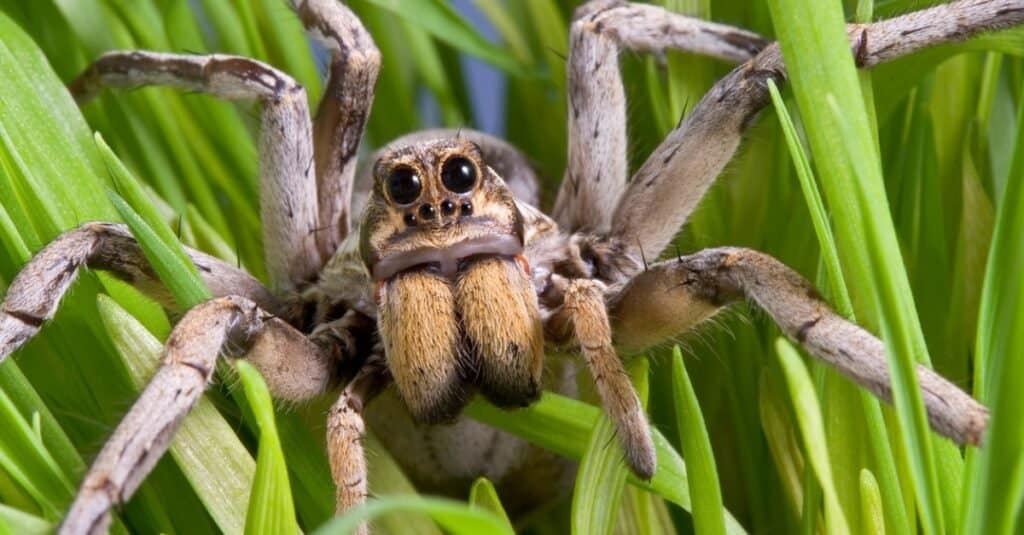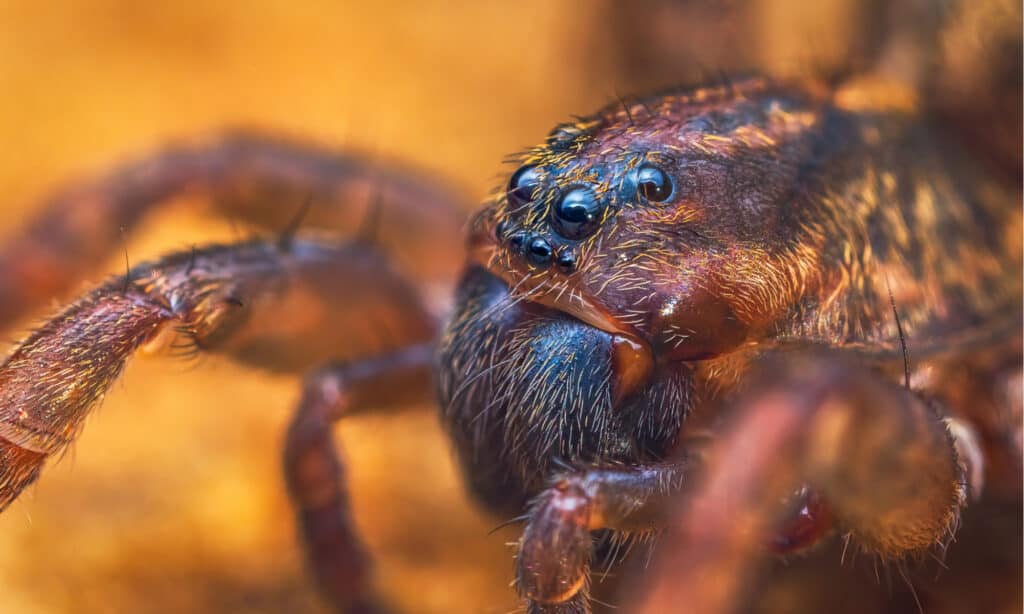Wolf spiders are among the most common spiders in Alabama. They are often easily spotted and have a bad reputation because of their big size and hairy appearance. If they were called “hairy brown besties” or simply “floofy brown teddies,” then most folks would probably attribute these creatures to harmless big brown creatures. Wolf spiders are found everywhere, and they thrive in a wide variety of habitats.
A long time ago, a biologist thought that these spiders hunted in packs, just like wolves, so he named the family Lycosidae, derived from the Ancient Greek word “lúkos,” meaning wolf. Well, as it turns out, wolf spiders aren’t as scary as most people would expect.
Here’s everything you need to know about wolf spiders in Alabama!
What Are Wolf Spiders?

Wolf spiders are robust and agile mid-sized spiders in the
Lycosidaefamily.
©iStock.com/CathyKeifer
Wolf spiders are robust and agile mid-sized spiders in the Lycosidae family. It’s the most diverse spider family, with approximately 2,900 species grouped into 124 known genera of wolf spiders. Despite their fearsome appearance, wolf spiders are typically not very big. Their body sizes range between 0.24 and 1.2 inches long, and they weigh less than an ounce. Wolf spiders exhibit low to moderate sexual dimorphism, with females slightly larger than males.
How To Identify Wolf Spiders in Alabama
Wolf spiders can be identified by their big eyes, thick bodies, and long legs. They come in brown, gray, or black colorations, sometimes blended with tan or light orange markings. They do not possess the flashy appearance of other spiders since they depend on camouflage for protection.
Wolf spiders have eight eyes lined-up in three rows. The top row has two medium-sized eyes, the middle row has two very big eyes, which distinguishes them from other spiders, and the bottom row, just above the mouth, has four small eyes, which provide secondary vision.
Where Are Wolf Spiders Found in Alabama?

Wolf spiders’ most common habitats include wet coastal forests, shrublands, gardens, and human homes.
©Judy Gallagher / Creative Commons – License
Wolf spiders are found in numerous habitats throughout Alabama. Their most common habitats include wet coastal forests, shrublands, gardens, and human homes. Most wolf spiders are wanderers and do not settle in permanent homes. However, some species have specific microhabitat needs, such as montane-herb fields or stream-side gravel beds.
Wolf spiders spend much of their time above the ground roaming the vegetation. Sometimes they make holes under rocks or dig burrows to live in. Their brown and dark colors help them blend with the decaying matter while hunting or avoiding predators.
What Do Wolf Spiders Eat in Alabama?
Wolf spiders primarily eat insects. They are insectivores, and their diet mainly consists of beetles, earwigs, ants, grasshoppers, and aphids.
Wolf spiders are often considered “beneficial bugs” because they clean gardens and farms of pest species. Although considered insectivores, wolf spiders may hunt small amphibians and reptiles, including frogs and toads, if they can.
Unlike most spiders, wolf spiders are nocturnal and mainly hunt at night. They have excellent night vision that aids them in spotting prey. They don’t spin webs to catch prey but run the prey down and pounce on its back using their long, powerful legs. With strong jaws, wolf spiders hold the prey and inject venom enough to paralyze or kill it.
Alternatively, wolf spiders may dig burrows or camouflage with the surroundings to help them find prey. Once inside the burrow, they wait for the prey to walk by and lunge at it using their strong legs.
Wolf Spider Predators in Alabama

Wolf spiders are vulnerable to predation from small mammals, including reptiles and amphibians.
©Lukas Jonaitis/Shutterstock.com
As dangerous as they may seem, wolf spiders are vulnerable to predation from small mammals, including reptiles and amphibians. Spider-eating birds, rodents, and lizards pose a major threat to wolf spiders. A wolf spider’s venom isn’t as effective on them as on small insects. Still, wolf spiders can resort to several defense mechanisms when threatened by predators. They can even detach a leg deliberately to escape the predator since they can regenerate a new limb over time.
Are Wolf Spiders in Alabama Dangerous?
Although they inspire fear in humans, wolf spiders do not pose a threat to people. They are shy around humans and prefer to escape rather than sting. However, they fight back when provoked or cornered. Their stings are not poisonous, but one can be allergic to their venom.
Wolf Spider Reproduction, Babies, and Lifespan
Wolf spiders exhibit very complex secondary sexual characteristics and courtship behaviors, such as the tufts of bristles on their legs, mostly seen with males. At the beginning of every mating season, males wave their pedipalps to court females. Unlike many other spiders, wolf spiders are very selective when finding a suitable mate. It’s believed that males can sense past sexual behavior and sexual ability from the female’s silk-associated pheromones and other semiochemical compositions.
Female wolf spiders tend to eat the males if the encounter goes wrong. This may happen even before mating.
Females who have already mated lay dozens of eggs and carry the egg sac around their abdomen. The baby wolf spiders will emerge from the sac after hatching and climb on their mother’s back for the remainder of their juvenile lives. While you might be tempted to step on one of these spiders, you should avoid doing this to a female spider since the impact of any object will cause the young to scatter through your home.
Most wolf spiders live for one to two years. Due to their short lifespans, they need to produce as many offspring as possible. Besides, female wolf spiders that have already mated in their lifetime have a lower probability of doing it again.
Up Next:
- 10 Spiders in Alabama
- The 5 Biggest Spiders in Alabama
- Wolf Spiders in South Carolina: Everything You Need To Know
The photo featured at the top of this post is © iStock.com/CathyKeifer
Sources
- Terminix, Available here: https://www.terminix.com/blog/science-nature/squishing-a-wolf-spider/
- Taylor & Francis, Available here: https://www.tandfonline.com/doi/abs/10.3109/19401736.2014.958696?cookieSet=1
- University of California Press, Available here: https://online.ucpress.edu/abt/article-abstract/81/8/561/20709/Spiders-by-Night-An-Outdoor-Investigation
Thank you for reading! Have some feedback for us? Contact the AZ Animals editorial team.






